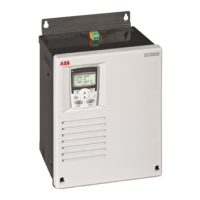77
Firmware description
3ADW000379R0501 DCS550 Manual e e
DC-breaker
General
The DC-breaker is used to protect the DC-motor or - in case of too low mains voltage or voltage dips - the
generating bridge of the drive from overcurrent. In case of an overcurrent the DC-breaker is forced open by its
own tripping spring.
DC-breakers have different control inputs and trip devices:
− an On / Off coil with a typical time delay of 100 to 200 ms,
− a high speed tripping coil (e.g. Secheron = CID) to trip the DC-breaker within 2 ms from e.g. the drive,
− an internal tripping spring which is released by overcurrent and set mechanically
There are different ways how to control the DC-breaker depending on the available hardware and the
customers on / off philosophy. The following is the most common.
AC- and DC-breaker controlled by the drive
AC- and DC-breaker controlled by the drive
In the above example, the drive controls both, the AC- and the DC-breaker. The drive closes and opens both
breakers with the command MainContactorOn. The result is checked by means of MainContAck (10.21) and
DC BreakAck (10.23). In case the main contactor acknowledge is missing F524 MainContAck [FaultWord2
(9.02) bit 7] is set. In case the DC-breaker acknowledge is missing A103 DC BreakAck [AlarmWord1 (9.06)
bit 2] is set, ± is forced to 150° and single firing pulses are given.
Trip the DC-breaker actively by the command Trip DC-breaker
Command Trip DC-breaker
Command Trip DC-breaker
The firmware sets the:
− command Trip DC-breaker (continuous signal) [CurCtrlStat1 (6.03) bit 14] and
− command Trip DC-breaker (4 s pulse signal) [CurCtrlStat1 (6.03) bit 15]
by means of
− F512 MainsLowVolt [FaultWord1 (9.01) bit 11] in regenerative mode or
− F502 ArmOverCur [FaultWord1 (9.01) bit 1].
In case a digital output - see group 14 - is assigned to one of the two signals, it is updated immediately after
detecting the fault and thus actively tripping the DC-breaker.

